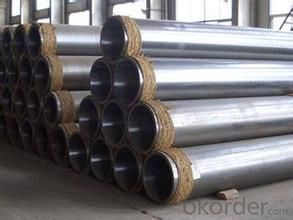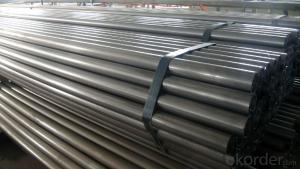API Galvanized Stainless Steel Pipe With 2 Plastic Pipe Caps
- Loading Port:
- Tianjin
- Payment Terms:
- TT OR LC
- Min Order Qty:
- 35 m.t.
- Supply Capability:
- 5000 m.t./month
OKorder Service Pledge
OKorder Financial Service
You Might Also Like
Item specifice
API Galvanized Stainless Steel Pipe With 2 Plastic Pipe Caps
1.Structure of Stainless Steel Pipe :
Seamless pipe is formed by drawing a solid billet over a piercing rod to create the hollow shell. As the manufacturing process does not include any welding, seamless pipes are perceived to be stronger and more reliable. Historically seamless pipe was regarded as withstanding pressure better than other types, and was often more easily available than welded pipe.
2.Main Features of the Stainless Steel Pipe :
• High manufacturing accuracy
• High strength
• Small inertia resistance
• Strong heat dissipation ability
• Good visual effect
• Reasonable price
3.Stainless Steel Pipe Specification:
Standard | GB, DIN, ASTM ASTM A106-2006, ASTM A53-2007 |
Grade | 10#-45#, 16Mn 10#, 20#, 45#, 16Mn |
Thickness | 8 - 33 mm |
Section Shape | Round |
Outer Diameter | 133 - 219 mm |
Place of Origin | Shandong, China (Mainland) |
Secondary Or Not | Non-secondary |
Application | Hydraulic Pipe |
Technique | Cold Drawn |
Certification | API |
Surface Treatment | factory state or painted black |
Special Pipe | API Pipe |
Alloy Or Not | Non-alloy |
Length | 5-12M |
Outer Diameter | 21.3-610mm |
Grade | 20#, 45#, Q345, API J55, API K55, API L80, API N80, API P110, A53B |
Standard | ASME, ASTM |
1) Material:20#(ASTM A 106/A53 GRB.API5LGRB,GB),45#,16Mn,10#.
2) Specification range:OD:21.3-610mm,WT:6-70mm,length:6-12m or according to the requirement of clients.
3) Excutive standards:GB,ASME API5L.ASTM A 106/A53,Despite of the above standards,we can also supply seamless steel pipe with standard of DIN,JIS,and so on,and also develop new products according to the requirements of our clients!
4) Surface:black lacquered,varnish coating or galvanized.
5) Ends:Beveled or square cut,plastic capped,painted.
6) Packing:bundles wrapped with strong steel strip,seaworthy packing.
4. Packing and Delivery:
Packaging Details: | seaworthy package,bundles wrapped with strong steel strip |
Delivery Detail: | 50-60days after received 30%TT or Original LC |
5. FAQ of Stainless Steel Pipe
A. How is the quality of your products?
Our products are manufactured strictly according to national and internaional standard, and we take a test on every pipe before delivered out. If you want see our quality certifications and all kinds of testing report, please just ask us for it.
Guaranteed: If products’ quality don’t accord to discription as we give or the promise before you place order, we promise 100% refund.we are factory and be able to give you lowest price below market one, and we have a policy that “ for saving time and absolutely honest business attitude, we quote as lowest as possible for any customer, and discount can be given according to quantity”,if you like bargain and factory price is not low enough as you think, just don’t waste your time.Please trust the quotation we would give you, it is professional one.
B. Why should you chose us?
Chose happens because of quality, then price, We can give you both.Additionally, we can also offer professional products inquiry, products knowledge train(for agents), smooth goods delivery, exellent customer solution proposals.Our service formula: good quality+good price+good service=customer’s trust
SGS test is available, customer inspection before shipping is welcome, third party inspection is no problem.
Any question, pls feel free to contact us !
6.Stainless Steel Pipe Images:


7. Company Information:
CNBM International Corporation (CNBM International) is the most important trading platform of CNBM Group Corporation, a state-owned company under the direct supervision of State-owned Assets Supervision and Administration Commission of the State Council.
Since 2004, the trading volume of CNBM International has been doubled in 5 successive years owing to the support of superior corporations and effort of all staff. Meanwhile, we have established strategic partnerships with hundreds of domestic manufacturers and sound business relations with clients from over 120 countries. Currently, we have wholly-owned overseas subsidiaries and branches in 5 countries with a view to realize localization, which also represents an essential progress in our globalization target.

In line with the business, CNBM International launched E-business platform Okorder.com.Our goal is to transform CNBM International into the global leading brand in building materials industry within 3 to 5 years through innovation and reform, by strengthening the overall management of supply chain, developing and cultivating both domestic and overseas market, improving the procedure and information system, enhancing the ability to organize resources and to provide value-added services under a professional team and a learning organization.
- Q:What is the difference between 316 and 316H stainless steel pipes?
- The main difference between 316 and 316H stainless steel pipes lies in their carbon content. 316 stainless steel has a maximum carbon content of 0.08%, while 316H stainless steel has a higher carbon content, ranging from 0.04% to 0.10%. This slight increase in carbon content enhances the high-temperature strength and creep resistance of 316H stainless steel, making it suitable for applications where elevated temperatures are involved.
- Q:How do stainless steel pipes compare to polyvinyl chloride pipes?
- Two popular options for plumbing and industrial applications are stainless steel pipes and polyvinyl chloride (PVC) pipes. These pipes have distinct characteristics and advantages, making them suitable for different purposes. To begin with, stainless steel pipes are renowned for their exceptional durability and strength. They can withstand corrosion, rust, and extreme temperatures, making them ideal for harsh environments and outdoor use. Furthermore, stainless steel pipes have a long lifespan and require minimal maintenance, reducing replacement and repair costs over time. On the other hand, PVC pipes are lightweight and easy to install, making them a cost-effective choice for residential and commercial plumbing systems. They resist chemicals and provide good insulation. PVC pipes are also non-conductive, making them suitable for electrical applications. Additionally, PVC pipes are typically less expensive than stainless steel pipes, which is important for projects on a tight budget. Another important factor to consider is the environmental impact. Stainless steel pipes are fully recyclable, making them an environmentally friendly option. However, PVC pipes can raise environmental concerns due to the use of chlorine during production and the challenges of recycling. Ultimately, the decision between stainless steel pipes and PVC pipes depends on various factors, including the specific application, budget, durability requirements, and environmental considerations. While stainless steel pipes excel in terms of durability and resistance, PVC pipes are cost-effective and easy to install. It is crucial to assess the project's needs and consult professionals to determine the most suitable option for each case.
- Q:Can stainless steel pipes be insulated with polyurethane?
- Certainly! Polyurethane insulation is frequently utilized in multiple industries, such as plumbing and HVAC systems, for both thermal and acoustic insulation. Its outstanding thermal conductivity properties and minimal moisture absorption make it an excellent option for insulating stainless steel pipes. There are two methods to apply polyurethane insulation: as a foam or in pre-insulated pipe sections. By minimizing heat loss or gain, avoiding condensation, and enhancing energy efficiency, it effectively insulates the pipes. Moreover, polyurethane insulation is long-lasting, lightweight, and corrosion-resistant, making it a suitable choice for insulating stainless steel pipes in diverse applications.
- Q:What is the difference between SCH and XS stainless steel pipes?
- Two distinct schedules or pipe thicknesses are employed in stainless steel pipes, namely SCH and XS. SCH represents schedule, while XS signifies extra strong. The primary disparity between SCH and XS stainless steel pipes can be found in their wall thickness. SCH pipes possess a standardized thickness range, whereas XS pipes exhibit a thicker wall in comparison to SCH pipes. SCH pipes are commonly utilized for general-purpose applications where elevated pressure is not a significant concern. They are available in various schedules, such as SCH 5, SCH 10, SCH 40, and so forth. The schedule number increases as the wall of the pipe thickens. SCH pipes are suitable for applications involving low to medium pressure. Conversely, XS pipes are engineered to withstand higher pressure and are frequently employed in more demanding scenarios. XS pipes possess a thicker wall than SCH pipes, offering enhanced strength and durability. They are prevalent in industries such as oil and gas, chemical processing, and power plants, wherein high pressure and corrosive environments are prevalent. To summarize, the primary distinction between SCH and XS stainless steel pipes lies in the thickness of their walls. SCH pipes possess a standardized thickness range, while XS pipes exhibit a thicker wall specifically tailored for high-pressure applications.
- Q:How do you prevent galling in stainless steel pipes?
- One way to prevent galling in stainless steel pipes is by applying an anti-seize compound or lubricant to the threaded connections. This helps to reduce friction and prevents the surfaces from seizing together. Additionally, ensuring proper thread engagement and avoiding excessive tightening can also help prevent galling.
- Q:How is stainless steel pipe different from carbon steel pipe?
- Stainless steel pipe and carbon steel pipe differ mainly in their composition and corrosion resistance properties. Stainless steel pipe contains a higher percentage of chromium, which forms a passive oxide layer on its surface, making it highly resistant to corrosion and oxidation. On the other hand, carbon steel pipe does not have this protective layer, making it more prone to rust and corrosion. Additionally, stainless steel pipe is generally more expensive than carbon steel pipe due to its superior corrosion resistance and durability.
- Q:Can stainless steel pipes be used in the petrochemical industry?
- Yes, stainless steel pipes can be used in the petrochemical industry. Stainless steel is highly resistant to corrosion and can withstand high temperatures, making it an ideal choice for transporting and storing various petrochemical products. Its durability and strength also make it suitable for handling the high-pressure conditions often encountered in the petrochemical industry. Additionally, stainless steel pipes are easy to clean and maintain, ensuring the purity and integrity of the petrochemical products being transported. Therefore, stainless steel pipes are commonly used in petrochemical plants, refineries, and other facilities within the industry.
- Q:Can stainless steel pipes be used for exhaust systems?
- Yes, stainless steel pipes can be used for exhaust systems. Stainless steel is a popular material for exhaust systems due to its high resistance to corrosion and heat. It can withstand the extreme temperatures and harsh conditions that exhaust systems are subjected to, making it a durable and long-lasting option. Stainless steel pipes also have the advantage of being lightweight, which can help improve the performance of the exhaust system. Additionally, stainless steel pipes can be easily bent and shaped, allowing for customization to fit different vehicle models and configurations. Overall, stainless steel pipes are a reliable choice for exhaust systems, providing excellent performance and longevity.
- Q:Are stainless steel pipes suitable for fertilizer production?
- Yes, stainless steel pipes are suitable for fertilizer production. Stainless steel pipes offer a number of advantages that make them a preferred choice for use in the fertilizer industry. Firstly, stainless steel pipes are highly resistant to corrosion, which is particularly important in the production of fertilizers. Fertilizer production involves the use of chemicals and substances that can be highly corrosive, such as ammonia, sulfuric acid, and phosphoric acid. Stainless steel pipes can withstand the corrosive effects of these substances, ensuring the integrity and longevity of the piping system. Additionally, stainless steel pipes have excellent strength and durability, making them able to withstand the high pressures and temperatures often encountered in fertilizer production processes. This ensures the safe and efficient transportation of the fertilizer materials within the production plant. Furthermore, stainless steel pipes are hygienic and easy to clean, which is crucial for maintaining the purity of the fertilizer products. Stainless steel has a smooth surface that resists the buildup of bacteria, dirt, and other contaminants, ensuring that the pipes do not contaminate the fertilizer during production. Lastly, stainless steel is a sustainable and environmentally friendly material. It is 100% recyclable, making it a more sustainable choice compared to other pipe materials. Additionally, stainless steel has a long lifespan, reducing the need for frequent replacements and minimizing waste. In conclusion, stainless steel pipes are highly suitable for fertilizer production due to their corrosion resistance, strength, durability, hygienic properties, and environmental benefits.
- Q:Are stainless steel pipes suitable for mining industries?
- Yes, stainless steel pipes are widely used and suitable for the mining industry. Stainless steel is known for its excellent corrosion resistance, making it ideal for applications in harsh and corrosive environments such as mines. This resistance to corrosion is particularly important in the mining industry, where pipes are exposed to various chemicals, water, and minerals that can accelerate the corrosion process. Additionally, stainless steel pipes are highly durable and can withstand extreme temperatures, making them suitable for the demanding conditions encountered in mining operations. Furthermore, stainless steel pipes offer high strength and reliability, ensuring the safe and efficient transportation of fluids, gases, and slurries throughout the mining process. Overall, stainless steel pipes are a preferred choice in the mining industry due to their corrosion resistance, durability, and strength, making them a reliable and long-lasting option for mining operations.
1. Manufacturer Overview |
|
|---|---|
| Location | |
| Year Established | |
| Annual Output Value | |
| Main Markets | |
| Company Certifications | |
2. Manufacturer Certificates |
|
|---|---|
| a) Certification Name | |
| Range | |
| Reference | |
| Validity Period | |
3. Manufacturer Capability |
|
|---|---|
| a)Trade Capacity | |
| Nearest Port | |
| Export Percentage | |
| No.of Employees in Trade Department | |
| Language Spoken: | |
| b)Factory Information | |
| Factory Size: | |
| No. of Production Lines | |
| Contract Manufacturing | |
| Product Price Range | |
Send your message to us
API Galvanized Stainless Steel Pipe With 2 Plastic Pipe Caps
- Loading Port:
- Tianjin
- Payment Terms:
- TT OR LC
- Min Order Qty:
- 35 m.t.
- Supply Capability:
- 5000 m.t./month
OKorder Service Pledge
OKorder Financial Service
Similar products
New products
Hot products
Related keywords




























